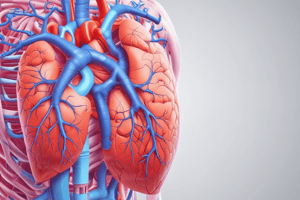Podcast
Questions and Answers
What is the respiratory membrane?
What is the respiratory membrane?
The thin membrane of alveoli where gas exchange takes place.
What are the 3 parts of the respiratory membrane?
What are the 3 parts of the respiratory membrane?
Squamous epithelia lining of alveolus, endothelial cells lining an adjacent capillary, and fused basal laminae between alveolar and endothelial cells.
What is diffusion like across the respiratory membrane?
What is diffusion like across the respiratory membrane?
Very rapid because distance is small and gases (O2 and CO2) are lipid soluble.
What is pneumonia?
What is pneumonia?
What happens in pneumonia?
What happens in pneumonia?
What is blood supply like to the respiratory surfaces?
What is blood supply like to the respiratory surfaces?
Where do respiratory exchange surfaces receive blood from?
Where do respiratory exchange surfaces receive blood from?
What surrounds each alveolus to give it blood supply?
What surrounds each alveolus to give it blood supply?
Where does blood from the capillaries pass through to return to the heart?
Where does blood from the capillaries pass through to return to the heart?
What supplies blood to the lungs?
What supplies blood to the lungs?
What is blood pressure like in the pulmonary circuit?
What is blood pressure like in the pulmonary circuit?
What can easily block pulmonary vessels?
What can easily block pulmonary vessels?
What is pulmonary embolism?
What is pulmonary embolism?
What are the 2 pleural cavities of the lungs separated by?
What are the 2 pleural cavities of the lungs separated by?
What is the function of each pleural cavity/what is it lined with?
What is the function of each pleural cavity/what is it lined with?
What are the 2 layers of the pleura?
What are the 2 layers of the pleura?
What is the function of pleural fluid?
What is the function of pleural fluid?
What processes are involved in the process of respiration?
What processes are involved in the process of respiration?
What is pulmonary ventilation?
What is pulmonary ventilation?
What is external respiration?
What is external respiration?
What is transported in the blood from the respiration processes?
What is transported in the blood from the respiration processes?
What is internal respiration?
What is internal respiration?
What is pulmonary ventilation?
What is pulmonary ventilation?
What is atmospheric pressure?
What is atmospheric pressure?
What is Boyle's law?
What is Boyle's law?
What is the equation representing Boyle's law?
What is the equation representing Boyle's law?
What is the inverse relationship of Boyle's law?
What is the inverse relationship of Boyle's law?
In a contained gas, what happens to pressure?
In a contained gas, what happens to pressure?
Flashcards are hidden until you start studying
Study Notes
Respiratory Membrane
- The respiratory membrane is a thin barrier in the alveoli where gas exchange occurs.
- Composed of three main parts:
- Squamous epithelium lining of the alveolus
- Endothelial cells of adjacent capillaries
- Fused basal laminae between the two cell types.
Gas Exchange
- Diffusion across the respiratory membrane is very rapid due to small distance and the lipid solubility of O2 and CO2.
Pneumonia
- Pneumonia is characterized by inflammation of the lung lobules.
- It causes fluid leakage into the alveoli, impairing the function of the respiratory membrane.
Blood Supply to Lungs
- Each lung lobule is supplied with an arteriole and a venule.
- Respiratory exchange surfaces receive deoxygenated blood from the pulmonary circuit.
Surrounding Alveoli
- A capillary network encircles each alveolus, providing necessary blood supply.
Returning Blood to the Heart
- Blood from alveolar capillaries flows through pulmonary venules and veins back to the left atrium.
Oxygen and Nutrient Supply
- Bronchial arteries supply oxygen and nutrients to the lung tissues involved in conducting pathways.
Pulmonary Circuit Pressure
- Blood pressure in the pulmonary circuit is relatively low at around 30 mm Hg.
Blockage of Pulmonary Vessels
- Pulmonary vessels can easily be blocked by blood clots, fat, or air bubbles, leading to complications.
Pulmonary Embolism
- Pulmonary embolism refers to blocked blood flow to the lungs, which can significantly hinder oxygen uptake.
Pleural Cavities
- The two pleural cavities containing the lungs are separated by the mediastinum.
- Each pleural cavity holds a lung, lined with a serous membrane called pleura.
Pleural Layers and Function
- The pleura has two layers:
- Parietal pleura (outer layer)
- Visceral pleura (inner layer)
- Pleural fluid provides lubrication and surface tension, aiding lung expansion and recoil.
Processes of Respiration
- Key processes involved in respiration include:
- Pulmonary ventilation (breathing)
- External respiration
- Gas transport
- Internal respiration
Definitions of Respiratory Processes
- Pulmonary ventilation refers to the movement of air into and out of the lungs.
- External respiration is the exchange of O2 and CO2 between the lungs and blood.
- Internal respiration involves O2 and CO2 exchange between systemic blood vessels and tissues.
Alveolar Ventilation
- Pulmonary ventilation facilitates the physical movement of air in and out of the respiratory tract, ensuring adequate alveolar ventilation.
Atmospheric Pressure
- Atmospheric pressure is the weight of air exerting physiological effects in the body.
Boyle's Law
- Boyle's Law describes the relationship between gas pressure and volume; it states that pressure inversely correlates with volume.
- The law can be represented by the equation P = 1/V.
- As the volume of a container decreases, the pressure rises; conversely, if the volume increases, pressure falls.
Gas Molecule Movement
- In a contained gas, external pressure forces molecules closer together, causing increased pressure from their movement against the container.
Studying That Suits You
Use AI to generate personalized quizzes and flashcards to suit your learning preferences.




